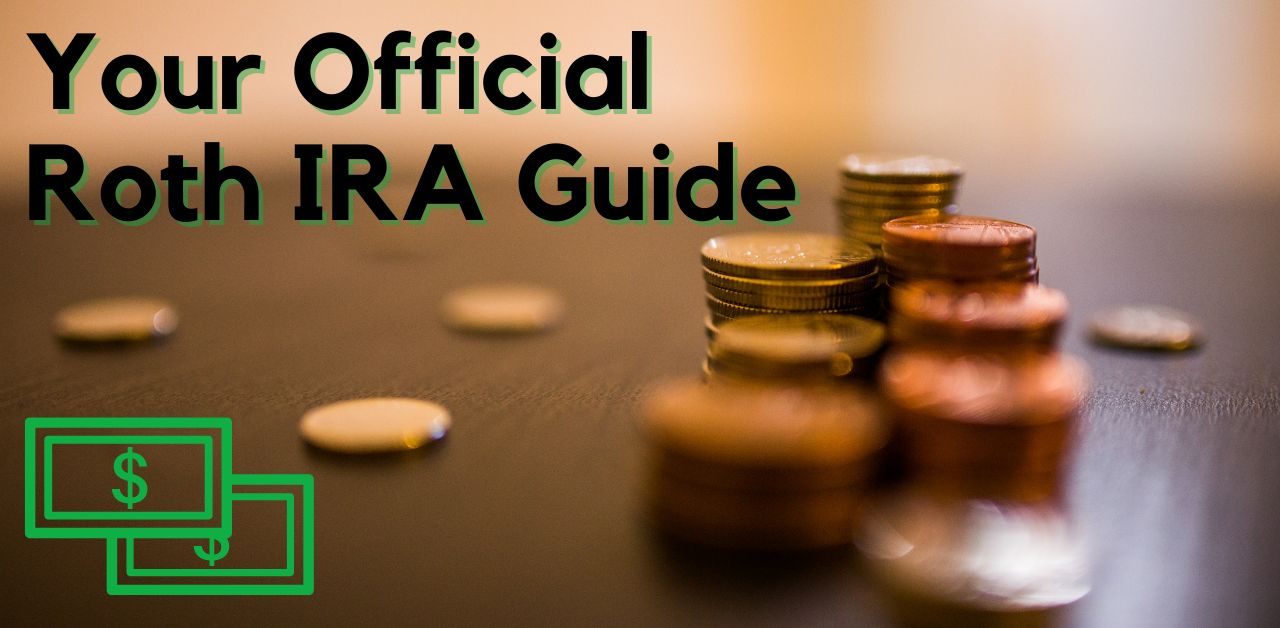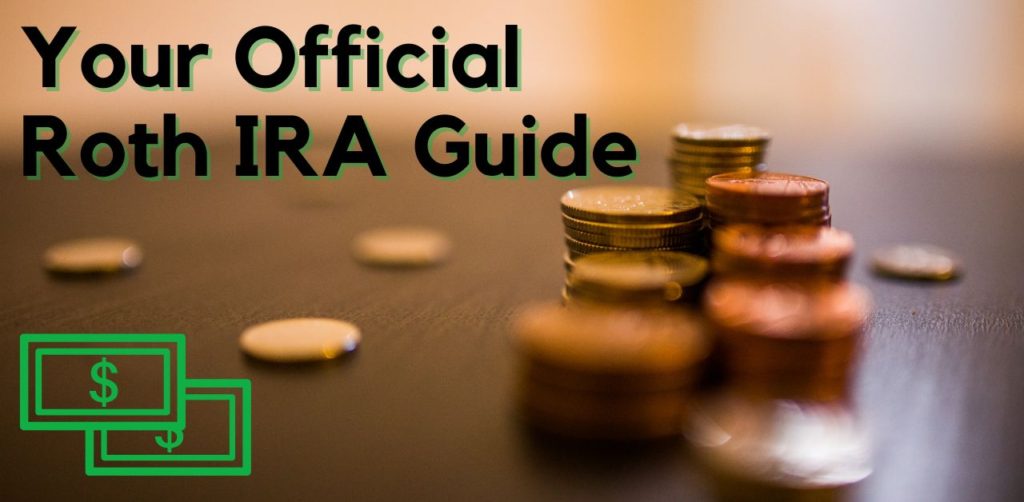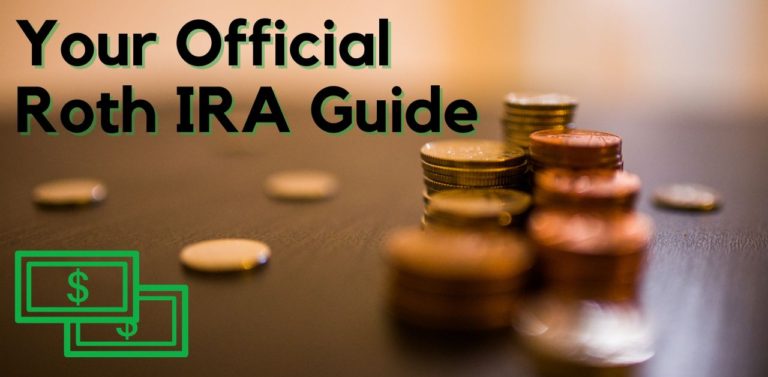Table of Contents
Introduction
In a study released to the public in February of 2019 by the LIMRA Secure Retirement Institute, it was found that 41% of Americans own either a traditional or Roth IRA and 19% of Americans own a Roth IRA.
Roth IRA’s were established in 1997, which is 23 years younger than the traditional IRA. Even though Roth IRA’s are less popular than traditional IRA’s, that does not make them less valuable.
If used properly under the right conditions, a Roth IRA is an invaluable retirement resource, and the mission of this blogpost is to take a deeper dive into this awesome account.
Roth IRA and Traditional IRA Comparison
A Roth IRA is a type of individual retirement account (IRA) that allows for tax free withdrawals as long as the withdrawals are qualified, more about that later. A Roth IRA differs from a traditional IRA through how they are taxed.

When you contribute to a traditional IRA, the dollars contributed into the account are pre-tax dollars. Pre-tax dollars symbolize money that has not been subject to any tax. Traditional IRA earnings grow tax free.
Taxes in a traditional IRA are delayed or deferred for when you withdraw money out of the account. When you invest money into a Roth IRA, the funds are taxed at the time of contribution. The money gained from your Roth IRA also grows tax free.
When you make qualified withdrawals from your Roth IRA, the distributions are not taxed. Since this is the case, the primary determining factor of whether a Roth IRA or traditional IRA is right for you is whether you believe you will be in a higher tax bracket today or when you take the distribution in the future.
Typically, many people will increase their earning power as they get older, so postponing or deferring their tax would not be the ideal choice, so a Roth IRA would be the proper selection for them.
However, if you believe that your earning power is at or near its peak currently, deferring your taxes would be the better decision, so choosing a traditional IRA would be a wise decision in this case. Both accounts are great assets to have on your personal balance sheet.
Eligibility Requirements
Roth IRA’s do have more eligibility requirements than traditional IRA’s. Anyone with earned income can contribute to a traditional IRA. There is also not an income limitation or phase out amount for traditional IRA’s.
With a Roth, you are allowed to contribute if you have an earned income. However, you become ineligible to contribute to a Roth under a few circumstances listed below:
Singles phase out 2021: Less than $140,000 MAGI with contributions starting to phase out at $125,000 MAGI (modified adjusted gross income).
Married couples phase out 2021: Less than $208,000 combined MAGI with contributions starting to phase out at $198,000.
Please note that it is only possible to open an IRA with an institution that has been granted approval from the IRS to offer these accounts. These institutions include brokerage firms, banks, federally insured credit unions, and savings/loan associations.
What is great about an IRA is that a minor can have their own account as long as someone at or above the age of 18 serves as the custodian on the account. Please be aware that the minimum age to open an IRA is based on the decision of the state you live in.
Some states require that a person be aged 19 or 21 in order to open an IRA account.
Contributions
Contributions into any IRA represent the initial amount of funds you invested into the account net any investment gains in the account itself. For both 2020 and 2021, the annual maximum contribution into either type of IRA is $6,000.
If an individual contributor is aged 50 or older, they are allowed to make an additional catch-up contribution of $1,000. This will allow them to contribute $7,000 on an annual basis.

You can contribute to a Roth IRA if you are aged 18 or older (in most states). If your annual income is lower than the maximum contribution of 6,000 or 7,000 depending on your age, you are able to contribute up to your total MAGI.
If you are in the phase out zone, Charles Schwab created a great table you can reference to view your maximum annual contributions based on your status for singles, married filing jointly and married filing separately that you can view here.
Contributions to your Roth IRA can be made at any point in the year. Time in the market will always prevail over timing the market in the long-term.
If you have a long-term time horizon and sufficient funds, contributing the $6,000 or $7,000 depending on your age at the beginning of the year is the best choice as your entire annual contribution will be invested in the market for the whole year.
If that is not the case, you can always allocate the $6,000 on any way you would like. If you made contributions on a monthly basis, it would be $500.00 per month or $583.33 if you are 50 or older.
Distribution Rules
The Roth IRA has the upper hand when it comes to distributions. You are not required to withdraw any money at any age or during your lifetime at all. This quality makes them great vehicles for transferring wealth.
With traditional IRA’s it becomes mandatory for you to begin taking required minimum distributions (that are of course taxable) at the age of 72, whether you need the funds or not.

The IRS provides tables and information regarding required minimum distributions. The amount you must distribute is calculated based on the age of the account holder as well as the amount of money in the account.
As a contributor to an IRA or employee sponsored 401(k) you may be eligible to receive an additional tax credit referred to as the savers credit. The credit is not made available for anyone under the age of 18.
The credit amount is also based on an individuals tax filing status, adjusted gross income and their total retirement plan contributions. In order to receive this credit, the individual must not be a full-time student or be claimed as a dependent on someone else’s tax return.
The maximum allowable credit for a head of household is $2,000 and for married couples filing jointly it is $4,000. Please refer to the 2021 table down below for more details.
Backdoor Strategy
Before getting into the backdoor Roth IRA strategy, it is important to understand that traditional IRA’s do not have income phase out/limits like the Roth IRA does.
Since these two accounts were not created equal in this regard, there has been a strategy devised to convert the traditional IRA to a Roth for individuals who earn more than the Roth phase out amounts.

According to Investopedia, since 2010 the IRS has not had income limits that restrict who can convert a traditional IRA to a Roth IRA, making the backdoor Roth possible.
There are three primary methods used to create a backdoor Roth IRA. The first method is to convert your entire traditional IRA to a Roth. Each institution handles this differently and you would have to contact them about this action.
The second method is to contribute money to your traditional IRA and then proceed to roll over the balance to a Roth IRA account. There is no cap to how much money you can roll over to a Roth either, so the Roth limits do not apply here.
A third strategy is to make an after-tax contribution to a 401(k) plan and then roll it over to a Roth IRA. Please note for the first and second strategy, the conversion is entirely a taxable event in order to convert those tax deferred contributions to an after-tax conversion.
Since this is a taxable event, be cautious and aware about being pushed into a higher tax bracket since the amount you are converting from that traditional account to a Roth will be added onto your income for the year.
Please note the emphasized “conversion” above. The money that you convert to the Roth from the IRA are converted funds. Your converted funds are subject to the 5-year rule. The waiting period for these converted funds begins when the traditional IRA funds are placed into your Roth account.
If you take out these funds before the 5 years is up or if you are younger than 59.5 then you will pay the 10% penalty tax on them when you take them out.
The reason why many people pursue this option is because Roth IRA’s do not have required minimum distributions (under most circumstances as you will notice they are present in the beneficiary section).
With a traditional IRA, required minimum distributions are mandatory across the board starting at age 72. Another benefit of this backdoor strategy is that there will most likely be tax benefits in the future for these account holders.
The account holders that engage in this strategy believe that they have not reached their peak tax bracket and that they will have more money to pay tax on in the future.
So, in order to mitigate their tax related costs, they decide to pay money on taxes today in a lower tax bracket so that they will not have to pay higher taxes in the future.
Be cautious and really analyze whether this is the right choice for you through your own research or through the guidance of a professional as the Tax Cuts and Jobs Act of 2017 banned the ability to reverse or recharacterize your Roth IRA back into a traditional IRA.
Remember that the Roth has annual contribution limits of $6,000 if you are under 50 years old and $7,000 if you are 50 years of age or older. Well, when you convert your traditional IRA to a Roth IRA, that contribution limit does not apply, you are able to convert all your traditional IRA funds to a Roth.
Pre-Retirement Withdrawals
This is where a Roth begins to shine even more. You are permitted to withdraw any amount up to the total amount you directly contributed to your Roth excluding any gains made in the account at any time, even before the age of 59.5 assuming you have owned your Roth for at least 5 years.
For example, let’s say you are 35 years old and you have directly contributed $100,000 into your Roth and you had investment gains of $20,000. Out of your total $120,000 account balance, you are allowed to take out $100,000 tax free if you have held the account for at least 5 years.

If you want to withdraw any of your investment gains, under most conditions you will be taxed. However, you can avoid being taxed or penalized if you qualify for any of the 5-year rule exceptions below.
Please note the emphasis on the word “direct” above. This is emphasized because a conversion from a traditional IRA to a Roth IRA or individuals who inherit an account from being a beneficiary have exceptions.
When an individual withdraws money from their Roth, the distributions are ordered in the following manner:
- Regular contributions
- Conversions and rollover contributions on a first in first out basis
- Earnings on contributions
If you had an existing Roth before you made the conversion, those regular contributions will be tax free when distributed. Once those Roth IRA contributions are gone, we hit the conversion and rollover contribution funds from your traditional IRA or 401(k).
These conversion or rollover amounts as well as earnings on contributions will be subject to not only ordinary income tax at the time of conversion but to a 10% penalty tax after conversion for an unqualified distribution unless you meet the qualifications for the 5-year rule exception.
Five Year Rule
The five-year rule is applicable under the three conditions noted in the pre-retirement withdrawal section:
- Conversion of a traditional IRA to a Roth
- If a beneficiary inherits a Roth
- Distribution of the investment earnings portion of your IRA balance
The five-year countdown begins when you make your first contribution to any Roth IRA. Even if you have multiple Roth IRA’s, the countdown for all Roth IRA’s you own applies to the IRA you opened first. Any rollovers from one Roth IRA to another does not reset the five-year countdown.
Conversions operate a little differently. You will pay ordinary income taxes on the conversion from a traditional IRA to a Roth given the deferred nature of the traditional IRA converted to the post tax dollars in a Roth at the time of conversion.
The 10% penalty tax does apply to conversions. If you make a conversion to a Roth before the end December 31, 2021 your 5-year clock for penalties on the principal starts January 1, 2021. If you converted in March of 2022, the clock starts ticking January 1, 2022 (within that particular tax year).
Unfortunately, the five-year clock countdown is unique to each account you convert. For instance, if you converted a traditional account in 2018 to a Roth, your countdown started in 2018 for those assets.
If you decided to convert another traditional IRA you own to a Roth in 2020, your 5-year countdown starts in 2020 for those assets, not 2018.
Under certain unique circumstances, your contributions and earnings may not be impacted by ordinary income tax or the unqualified distribution penalty tax. These exceptions are as follows:
You are permitted to use up to $10,000 to cover the cost of your first home.
Use the money to pay for higher education for a child, grandchild, spouse, or yourself (must be qualified educational expenses documented by the IRS).
Withdrawal of funds to pay for health insurance premiums under the condition that you are unemployed.
Unreimbursed medical costs that exceed 10% of your adjusted gross income.
For beneficiaries, when a Roth owner that has held the account for at least 5 years dies, you are allowed to take a distribution without penalty, this includes a spousal transfer.
Made because you’re totally and permanently disabled.
A qualified reservist distribution – a member of the military who is not active, but when he or she is called in for active duty, becomes eligible to make an early withdrawal from retirement account without the early distribution penalty.
Not in excess of $5,000 and the distribution is a qualified birth or adoption distribution.
Substantially equal periodic payments (SEPP’s) – when you need to make periodic withdrawals from your IRA under certain allowable stipulations. This is a topic on its own and is beyond the scope of this article, please visit this link to the IRS for more information.
For unpaid federal taxes – only applicable when the IRS draws on your IRA balance to pay the unpaid taxes. The 10% penalty will not be applicable if the IRS levies the money directly. You will be subject to the 10% penalty if you withdraw the money yourself and pay the taxes.
One Spouse Working and One Staying Home
One great feature of the Roth is that a couple filing jointly on a tax return where one spouse works and the other does not allows each spouse to each have their own Roth set up and both of them will be able to individually contribute $6,000 assuming their combined MAGI is above $12,000.
Investment Options
With a Roth IRA, you are able to invest in anything you desire. Whether it be individual stocks, mutual funds, ETFs, Indices, etc. It is easy to get 401(k)s mixed up with IRAs.
Any 401(k) is an employer sponsored retirement plan. You may have the freedom to invest in whatever you would like, but this depends on what the plan administrator and the employer have decided.
If a restriction is in place, it will most likely be a limited number of preselected investments available from the plan that you can choose from. Your annual max contributions for your 401(k) and IRA are independent, you can max them both out if you’d like, even if they are the same type (Roth IRA and Roth 401(k)).
Please be aware that any employer provided match will be taxable when you withdraw it in retirement. However, these matched funds are free money that the employer is providing you that you can grow your investments with, by all means, always accept the match.
Emergency Withdrawal Strategy
Withdrawing money out of your Roth IRA should be a last resort. A lot of people that may be thinking about this are under the age of 59.5 and if you have not had your Roth for 5 years and none of the five-year rule exceptions apply to you, then you will be subject to the 10% early withdrawal penalty tax.
This money is also working a lot harder for you than the money you have in your possession not gaining interest or funds in a high-yield savings account. The order of funds I would use in an emergency would be the following:
Money that I have in my possession > Money in a high-yields savings account > Money in a taxable investment account > Money in your 401(k)/IRA > Money in your HSA.
If you take money out of a health savings account (HSA) and use it for an ineligible expense according to the IRS, you will be subject to a 20% tax penalty as well as taxed at your ordinary income tax rate, ouch.
Beneficiaries
Completing the beneficiary section of your Roth is essential. When you sign up for a Roth, there should be a beneficiary section you can fill out to designate a beneficiary. If you left the section blank, you will be able to update this information with the institution you set your Roth up with.

If no beneficiary is set, there is a chance that the money may not go to the person you wish to have the money. Even if it does go to the right person, some of the tax benefits may be eliminated because the funds could get batched into your total estate and allocated according to the laws of your state.
The spouse of the Roth can treat the IRA as their own, they will become subject to the same distribution regulations as if it had been theirs to start off with. The assets will be transferred into their own new or existing Roth IRA.
Another option for the spouse is to open an inherited IRA using the life expectancy method where they will be required to take required minimum distributions but these RMD’s can start at the later of the two dates:
when the original account owner would have turned 72 or December 31st of the year following death. Distributions will be based on your life expectancy or the life expectancy of the eldest beneficiary if there are multiple beneficiaries.
The spouse can also open an inherited Roth using the 5-year method where the money is transferred to an inherited Roth in their name. They can spread the distributions in any way they want as long as they withdraw all the assets by December 31st of the 5th year after the death of the original owner.
The three methods above allows contributions to be withdrawn at any time, earnings will be taxable unless the 5-year rule was met by the original account owner. The beneficiary will not be subject to the 10% early withdrawal penalty, they can select their own beneficiary, and the assets are able to grow tax-free.
The last method is a lump-sum distribution, where all of the money in the Roth is distributed to the beneficiary. There will not be any tax on the contributions in the account, but the earnings are still taxable if the account was less than 5 years old when the original account owner died.
Please note that when a non-spouse inherits a Roth IRA, they are open to 3 of the 4 options noted above. The option that the spouse is allowed to take but non-spouse is not permitted to select is the spousal transfer.
Borrowing from a Roth IRA
It is not permissible to take a loan out from your Roth like it is with a 401(k). You are free to withdraw your direct contributions tax free (assuming you have had the Roth for 5 years or you fall under any of the 5-year rule exceptions or you are 59.5 or older).
Remember that rollover contributions have their own independent 5-year countdown starting when you actually made the conversion from a traditional IRA to a Roth.
The IRS does note that you are allowed to make a tax-free withdrawal of some or all of the funds inside your IRA with the stipulation that you will deposit the money back into the Roth or traditional IRA within 60 days.
However, this action is usually associated with Rollovers when an employee transfers their 401(k) balance into an IRA when they lose or change their jobs. This action is also taken if the employee wishes to have more freedom when it comes to their investment selection.
If you are unable to refund the entire amount of your withdrawal within the 60 days, the balance you keep will be subject to the 10% penalty tax unless you are 59.5 or older, applicable for a 5-year rule exception, or have had the IRA for 5 years or more.
Note that once you receive your distribution from a rollover, there is a 1-year waiting period before you can engage in another rollover. The 1-year clock begins once your distribution has been made.
IRA Transfer Taxes
When an account holder makes a direct transfer between one IRA to another, he or she will not be taxed. A direct transfer occurs when the institution you are exiting sends the funds directly to the institution with your new account.
If a check is instead sent to you and you deposit the check into the new account, you will be subject to a withholding penalty. Trustees or custodians are required to withhold 10% on IRA checks and 20% on distributions from other retirement accounts, whether or not the money is for a rollover.
The exception to this is if an account holder receives a distribution from a Roth IRA to rollover into a traditional IRA. This distribution is not a taxable event and the account owner does not need to report this distribution as income.
Closing Comments
This was certainly an enjoyable article to write as I became aware of certain rules that I was unaware of and that I will use if necessary, to maximize my benefits from the Roth IRA.
Have you looked into starting an IRA account? To ensure optimal quality, if there was anything that you would like to see that was not included in the article, please let me know in the comments, I’d be happy to add it in!








